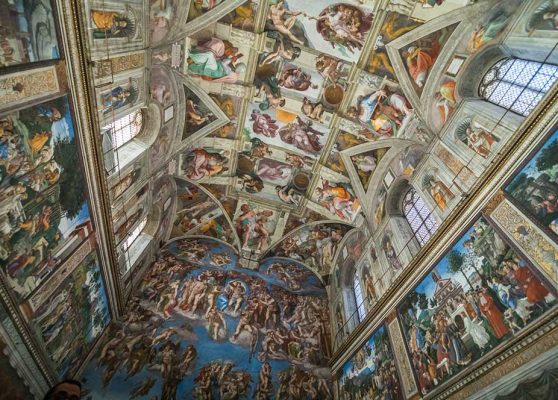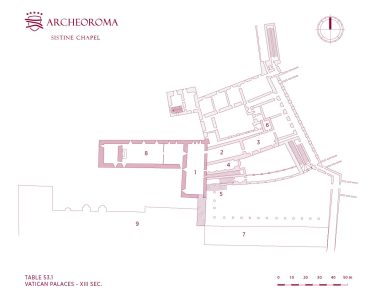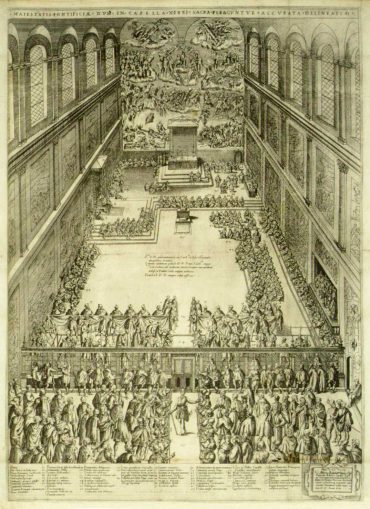Sistine Chapel
The Sistine Chapel is among the most visited monuments in the Vatican. Famous for Michelangelo’s frescoes and the extraordinary vault.
Location:
Vatican City, to the right of St. Peter's Basilica
Built by:
Architects Baccio Pontelli and Giovannino de 'Dolci between 1475 AD. and 1481 A.D.
What to see:
Sistine Chapel ceiling, Universal Judgment
Opening hours:
Monday to Saturday, 9:00 - 18:00
Price:
Standard ticket from 12 to 21 euros
Transport:
Metro Station: Ottaviano
Tours:
Most popular tours

Top selling tickets on ArcheoRoma
The Sistine Chapel is a structure belonging to the “Vatican Apostolic Palace”, a building of over 1,000 rooms which also includes the Vatican Museums and the papal apartment. Although this building is one of the 18 apostolic palaces (also papal palaces or pontifical palaces) found in Italy, mainly in Rome, today with this name only reference is made to the “apostolic palace at the Vatican”.
The Sistine Chapel was born from the remains of the Magna Chapel (also Domini Pape Chapel), one of the three structures mentioned by Giannozzo Manetti in the biography of Pope Nicholas V in 1455, located in a Vatican garden called “paradise”. The structure of the Magna Chapel was composed of self-supporting walls made of oblong bricks that developed on three levels.

The most reliable hypothesis is that it was built under Pope Innocent III (1161 – 16 July 1216). There is no doubt that the pope famous for his crusades against heretics built the first hall, which acts as an antechamber for the Magna Chapel. This is in fact perfectly parallel to the Saint Peter’s Basilica and at the same time perfectly aligned on the east-west axis with the future Sistine Chapel (as can be seen from fig. 1). It can be deduced that these were made by the pope himself, and that they represent the “chamber and chapel” mentioned in some biographical documents 1.

In the copper engraving (fig. 2) dated 1578, the French architect and painter Étienne Dupérac represented the Magna Chapel during the mass of the pontiff before it was rebuilt (lat. “Maiestatis pontificie dum in capella xisti sacra peragantur accurate delineatio”). The interior had a flat wooden ceiling as well as a wooden floor, tapestries with floral decorations on the walls and a large fresco behind the altar already representing the assumption of Mary (note: the people portrayed are disproportionate to the real size ).
The construction of the Sistine Chapel as we know it today was commissioned by Sixtus IV , elected pope in 1471. The project was born in a more general context of recovery of the monuments abandoned during the Avignon captivity.
Unlike what was stated in a panegyric of Sixtus IV, the Sistine Chapel was not created from scratch, but it was decided to keep the medieval, albeit irregular, walls of the Magna Chapel up to the height of the first frame. The demolition of the Magna Chapel probably began during the second half of 1475, since the new chapel was to be already under construction at the beginning of 1476 2.
The project, by Baccio Pontelli , provided for a substantial strengthening of the walls thanks to a brick curtain, which was started by Giovannino de ‘Dolci (both Florentine architects).
The first mass took place on August 15, 1483, on the occasion of the feast of the Assumption of the Virgin, during which the chapel was consecrated and dedicated to the Virgin Mary.
The pictorial interior decoration work presumably began in the second half of 1481 and ended at least in mid-May 1482. It can be seen from the description provided to us by Andreas Trapezuntius, private secretary of Pope Sixtus IV, who describes the chapel as complete (“omni ex parte” ) as early as the summer of 1482 3.
The west wall, behind the altar, was painted by Perugino while the vault, decorated with a starry sky, was the work of Piermatteo d’Amelia . In 1481 four panels on the north wall were frescoed by Sandro Botticelli , Cosimo Rosselli and Domenico Ghirlandaio . Subsequently, on the east wall (wall of the entrance to the Aula Prima) the “testament of Moses” and the “Contention around the body of Moses” were made by the Cortonese painter Luca Signorelli .
The early sixteenth century the Sistine Chapel suffered major damage probably due to the construction sites for the new Saint Peter’s Basilica , which concentrated mainly in an important crack on the vault. Bramante, architect of the palace, worked using a series of metal chains and dabbing the crack, but the starry sky of Piermatteo d’Amelia was irreparably damaged.
Despite the bad relations between the two, Julius II decided to entrust the decoration of the vault to Michelangelo Buonarroti , who returned to Rome in 1508 to sign the contract and start the work.
The foundations proved to be rather unstable in the years, so much so that on Christmas day in 1522 the collapse of the lintel of the east wall spared Pope Hadrian VI a little, killing a Swiss guard. In an attempt to secure the Sistine Chapel there was further damage to two frescoes belonging to the “Stories of Christ and Moses”, which were subsequently repainted by Hendrick Van de Broeck and Matteo da Lecce.
Between 1536 and 1541, Michelangelo Buonarroti was commissioned by Clement VII for the enormous fresco of the ” Last Judgment “. For the realization of this work Michelangelo destroyed two lunettes during the plaster laying phase in 1537.
This work, carried out on the west wall behind the altar, provoked important disputes between the then cardinal Carafa (later Pope Paul IV) and Michelangelo. The object of the dispute was the representation of nudes, considered obscene. After Michelangelo’s death (1564), the “Pictura in Cappella Ap [ostoli] ca copriantur” was promulgated by the Council of Trent, a law that censored nudity in religious art.
Daniele Ricciarelli (also known as Daniele da Volterra ) is responsible for the drapes and fig leaves that cover the naked figures, an intervention that was carried out in 1565.
The Sistine Chapel is a rectangular-based structure covered by a lowered barrel vault, in whose intersections with sails lunettes are formed. Under the six lunettes on each side we find the arched windows, the only light source for the environment.
The external measures of the plant have remained those of the Magna Chapel, to which is added the perimeter row of bricks. The overall external dimensions of the Sistine Chapel are:
| Length (east-west axis) | 40.5 meters |
| Width, east wall | 13.78 meters |
| Width, west wall | 13.11 meters |
| Height | 20.70 meters |
The vault was built between 1508 and 1512 by Michelangelo Buonarroti. It is considered to be one of the greatest masterpieces of art of all time. Tell the “Stories of Jesus and Moses” before the latter received the “tables of the law”.
Given the importance of this work, we will devote an entire study shortly.
The frescoes in the Sistine Chapel follow the rhythmicity of the windows that divide the space. The frescoes can be divided into three different registers:
The environment of the Sistine Chapel is divided on the east-west axis by a marble barrier made by Mino da Fiesole, Andrea Bregno and Giovanni Dalmata. This allows to divide spatially the area destined for religious functions (“Sancta Sanctorum”) from that destined for the faithful. Over the years the position has changed: while before it was towards the center of the room, at the height of the “Creation of Eve”, today it is in a more backward position, to give more space to the papal functions.
The supporting base of the barrier is finely decorated with marble bas-reliefs, where the papal coat of arms of Sixtus IV supported by putti stands out, while columns interspersed with metal nets support the architrave. In the center, the passage to the “Sancta Sanctorum”.
During religious celebrations the first level of the walls of the Sistine Chapel was covered by a series of tapestries commissioned by Pope Leo X, designed by Raphael and made by Flemish artists in the workshop of the famous tapestry maker Pieter van Aelst between 1515 and 1521. These tapestries , five meters wide and four meters high, reproduce stories taken from the Gospels and from the “Acts of the Apostles” relating to St. Peter and St. Paul. Today the tapestries are located in the Vatican Pinacoteca, more precisely in room VIII (“Raffaello’s Hall”).
In February 2020, on the occasion of the fifth centenary of Raphael’s death, the tapestries were reinstalled in their original location and admired by the public during visits to the Sistine Chapel.
Sistine Chapel: your opinions and comments
Have you visited this monument? What does it mean to you? What advice would you give to a tourist?
Sistine Chapel tickets